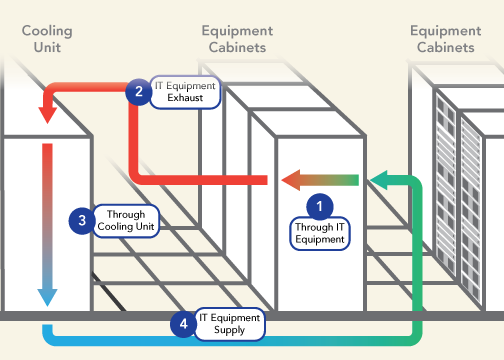The Different Data Center Delta Ts11 min read

Just as “Diversification” is always a good answer to what makes a good investment portfolio and just as “balance” is always a good answer to what makes an efficient football offense, so ΔT is still a good answer to what is the key to active data center cooling. However, just as diversification can mean some mix of stocks and bonds to one investor and can suggest some combination of liquid versus committed assets to another and just as balance can involve setting up the pass with the run for one coach but can also mean setting up the run with the pass for another coach, so data center Delta T can say different things to different participants. Clarifying our understanding of various ΔT’s in the data center will not only help us to have more meaningful conversations with our fellow data center practitioners from other disciplines (Are we still trying to get IT and facilities to happy hour together?), but this understanding will also provide us with insights on what these metrics can tell us about the health of our data center and the efficacy of our improvement projects.
In the unlikely event we are getting drive-by readings by English professors, massage therapists, dog walkers, graphic artists, politicians or anyone else outside our insular little world, let me just pause for a moment and clarify that by “ΔT” I mean the temperature difference of air before its encounter with something versus after its encounter with something. More precisely, we are talking about the temperature differences of liquids, with air being one of many possible liquids ranging from water to refrigerant in the physics of data center heat transfer. Specifically, for this discussion, I will be referring to the four ΔT’s illustrated below in Figure 1. The first ΔT is the temperature rise of the air resulting from passing through IT equipment, i.e., the temperature difference between server inlet air and server exhaust air. IT equipment vendors are typically referring to this difference when they use the term ΔT. The second ΔT is the temperature difference between the IT exhaust air and the cooling equipment inlet air. While the first ΔT can range from 15˚F to 60˚F based on the amount of heat removed from the IT equipment by convective heat transfer, the second ΔT should be minimal based on additional heat picked up from the room. As we shall see later, the operative word there is “should.” The third ΔT is the difference between the cooling equipment inlet air (return air) and the cooling unit exhaust (supply air). Ideally and theoretically, this ΔT should be the same as the IT equipment ΔT. That is to say; we would like to be removing the same value of heat as we are introducing through our IT equipment – the temperature drop across our cooling equipment should be about the same as the temperature increase across our IT equipment. Another way of stating that would be to say that the room or data center, should have the same ΔT as the IT equipment. Practically speaking, that almost never happens, but that is the goal, and that is a critical indicator of how efficiently a mechanical plant is cooling the data center. Facilities engineers are typically referring to this difference when they use the term ΔT, though being mechanical engineers they could be sneaking in any one of numerous temperature differences occurring through the overall heat rejection process. Finally, the fourth ΔT is the difference between the cooling equipment exhaust (supply air) and the server inlet temperatures (also confusingly enough called “supply temperature”). This ΔT will reflect any heat picked up by the supply air before being ingested by the data center IT equipment. The second and fourth ΔT’s tend to be addressed by nit-picking consultants (guilty as charged) working to troubleshoot mechanical plant inefficiencies or fine-tune spaces on an optimization path.

There are many other ΔT’s in the data center, particularly in the mechanical plant and of varying degrees of concern to facilities engineering. For example, in any indirect economizer air-to-air heat exchange, such as indirect evaporative cooling or re-purposed heat recovery wheel cooling, the ΔT’s between the scavenger air (outside ambient air temperature) and various other air masses will be revealing about the effectiveness of the cooling system and the associated airflow management disciplines. The ΔT between the scavenger supply and scavenger exhaust tells us how much heat we are removing from the data center. The ΔT between the scavenger supply and the recirculated supply tells us about the efficiency of the cooling plant. The ΔT between the scavenger supply and the recirculated return tells us about opportunities for partial free cooling at higher temperatures. Indirect air economization, the ΔT between ambient supply and data center return will reveal opportunities for partial free cooling when the ambient supply exceeds the target supply temperature. Likewise, the ΔT between ambient supply temperature and supply target can tell us when we need to re-circulate some waste air to keep delivered supply above service level agreement minimums. We are also concerned about ΔT’s for tower return (EWT) and tower supply (LWT) and tower versus wet bulb ambient, as well as the ΔT for water or another coolant through equipment cooling coils. While all these mechanical plant ΔT’s are to one degree or another associated with the airflow management practices in the data center, the four ΔT’s in Figure 1 are direct metrics of airflow management effectiveness.
A very compelling case could be made for beginning any optimization project with an assessment of the third ΔT and using that as a surrogate for the overall airflow management health of the data center. While that may represent a reasonable quick snapshot, the data center is an ecosystem, and any problems with the other three ΔT’s can produce false positives or false negatives at the third ΔT across our cooling equipment. In my next three pieces, I will be exploring each of these ΔT’s more closely and providing guidance on how to measure and how to use those measurements to assess airflow management effectiveness. I will also describe some of the pitfalls of relying on any one of these measurements exclusively.

Ian Seaton
Data Center Consultant
Let's keep in touch!
Airflow Management Awareness Month
Free Informative webinars every Tuesday in June.
0 Comments